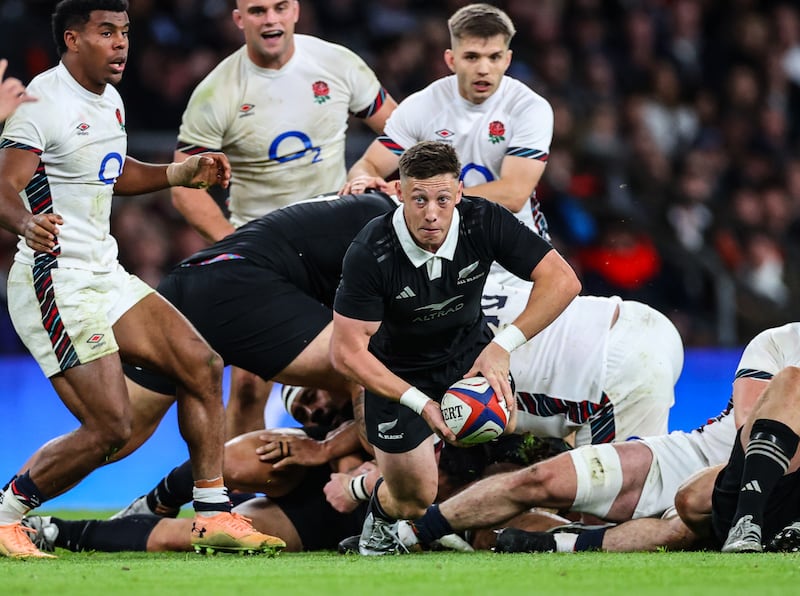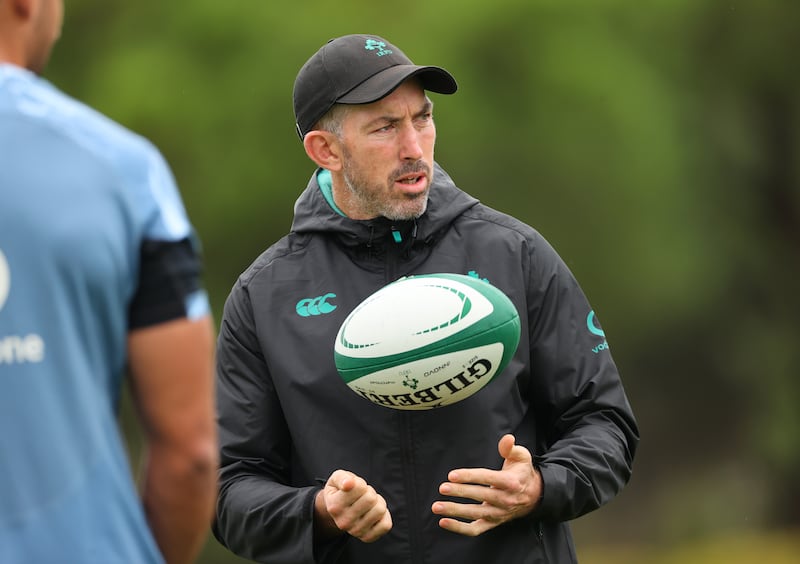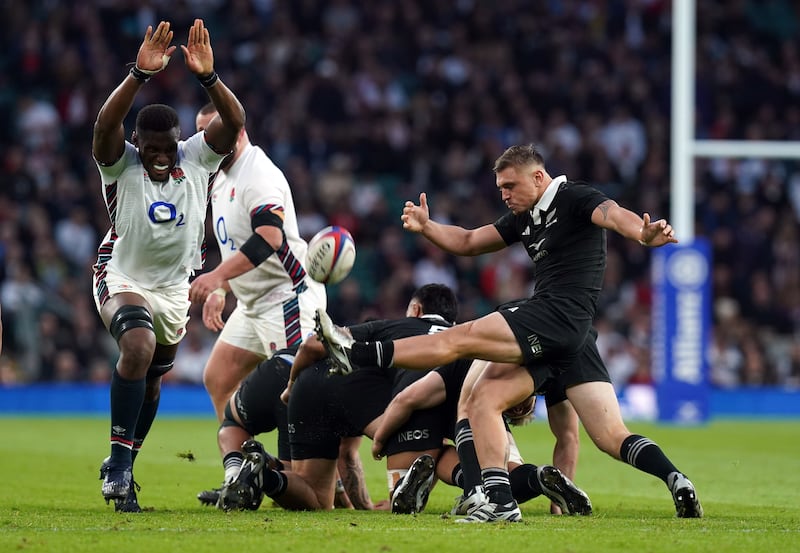Dominant Doris
In his first game as full-time captain, Caelan Doris will be Ireland’s most noteworthy figure. Captaincy or otherwise, he was already one of, if not the most, important player to the Irish attack.
In last year’s Six Nations, Doris led the total carries for Ireland. Only England’s Ben Earl took the ball into contact more often. Along with Bundee Aki, Doris is regularly tasked with setting the tone for Ireland’s attack. Front-foot ball allows Ireland’s intricate phase play time to strike at a disorganised defence. As Doris’s carrying wanes, with it goes the Irish threat.
New Zealand targeted Doris during last year’s World Cup quarter-final with two-man tackles. During his first two carries of that game, Doris lost control in contact and then conceded a turnover to Ardie Savea after Sam Cane ruthlessly chopped him down.
Doris beat two defenders in that game. In South Africa, he beat five over the two matches. So far this season, Doris has fought past 18 would-be tacklers in just three games. He is in the top 10 in the URC for that metric despite playing in only half of the games of this campaign; he has been dominant.
READ MORE
URC opposition is not comparable to the All Blacks. But if Doris continues to trend upwards, or at least can get close to his current attacking production, Ireland will be in a good place.

Convert at the ruck
Coming into the meeting between these two sides 12 months ago, New Zealand had the fastest ruck speed of all teams at that World Cup. Joe Schmidt brought his famed breakdown detail to the All Blacks’ coaching ticket.
However, in that quarter-final, Ireland slowed them down on the floor. Just 40 per cent of New Zealand rucks were classified as ‘quick’ (0-3 seconds). Ireland’s figure was 59 per cent.
Despite having significantly slower ball, the All Blacks did more with it, with 90 per cent of their attacks ending in a positive outcome (avoiding an error or a turnover), compared to 72 per cent of Ireland’s.

Are New Zealand underdogs against Ireland?
Simon Easterby’s defence got halfway to stopping the All Blacks at source, but they couldn’t finish the job. They earned just one solitary ruck turnover that night. It isn’t a perfect comparison but, when they beat the Springboks in July, Ireland forced four.
A year on, the All Blacks still had a decent but not stellar quick ball percentage of 40 against England. Yet Steve Borthwick’s team did not win a ruck turnover until the 50th minute.
Quick ball is important, but the easiest way to stop the attack is to take possession away. As England learned the hard way, the All Blacks are too skilled; the longer they hold on to the ball, the better their chances of breaking down defences. They threw an astonishing 23 offloads out of the tackle at Twickenham, two of which directly set up tries.
The best way of preventing this? Ireland need their breakdown poachers not just to slow the ball down, but to consistently win it back.

Efficient attack
Ireland’s attacking ruck speed has been excellent for some time. Last season their rate of quick ball – rucks lasting fewer than three seconds – topped out at 64 per cent versus Italy. Not since Ireland beat the Springboks in last year’s World Cup has that figure dipped below 50 per cent.
Despite the emphasis placed on speed of ball, Ireland’s attack hasn’t always taken advantage. Quick ball makes it easier to advance down the pitch, to enter the opposition’s 22 and then cross the try line.
At the start of last season’s Six Nations, Ireland’s efficiency once inside the 22 was excellent. Against France, they scored 4.22 points per visit. When beating Italy, that figure was 3. Against Wales, it rose to 3.11.
From then on, things started looking less pretty. They scored 2.29 points per 22 entry in the defeat to England. In the next three games against Scotland and South Africa, only once did Ireland reach two points per entry. In last year’s loss to the All Blacks, Ireland only scored 1.4 points per 22 visit despite getting there 15 times, more so than any game they have played since.
Ireland’s attack, thanks in a large part to the side’s breakdown work, is forcing defences to bend. More and more often, though, they don’t break.
New assistant coach Andrew Goodman travelled to South Africa but this is the first time he works solely with Andy Farrell – without Mike Catt – on Ireland’s attack. Friday night, and the remainder of Ireland’s November fixtures, will show if they have evolved to become more efficient.

Kicking game
Those who watched New Zealand on Saturday would have noticed a new buzzword enter the rugby lexicon. Get used to hearing “Access” shouted by referees as wingers chase high balls.
This November, World Rugby has asked officials to clamp down on kick escorts, the practice of receiving teams using blockers to impede kick chasers. Teams fielding kicks must now allow ‘access’ for those chasing to allow for an aerial contest.
The game at Twickenham, the first under the new directive, featured a combined 33 handling errors from both sides. Statistically, it’s too early to say higher error counts are definitively due to the new kicking laws, but it nevertheless stands that more contests for possession are likely to see more loose ball.
The All Blacks kick more often than would be expected given their reputation. Against Ireland last year, they kicked a staggering 85 per cent of their possession away. On Saturday, their first-half strategy was to kick as soon as England’s blitz defence looked threatening. After half-time they held on to the ball more but still finished with 30 kicks from hand, just three shy of their total from that World Cup quarter-final.
This all means Ireland’s back three of Hugo Keenan, Mack Hansen and James Lowe can expect to be tested, without the protection of a kick escort. However, the reverse remains true. Ireland’s varied kicking game can challenge New Zealand’s backfield coverage. While Will Jordan and Mark Tele’a had their strong aerial moments in Twickenham, errors still came.
Committing fewer errors in the air will be vital in the battle for territory on Friday night. When inevitable spills do happen, the scrum will come into play. Controversially, New Zealand forced numerous penalties from Ireland and Andrew Porter last year. On Saturday, 140+kg replacement tighthead Pasilio Tosi did a job on the English scrum. Ireland will be tasked with preventing a repeat of the set-piece dose.

Start fast, finish strong
While not being the sole determining factor, it remains true that on the last five occasions these sides met, whoever scored the first try went on to win the game. The only exception was the first Test in Eden Park two years ago, which the All Blacks won after Keith Earls’s early score.
Fast starts aren’t sacrosanct, but given the difficulty in flipping momentum in Test rugby, they certainly are important. In the two games which Ireland lost since the World Cup – England and the first Test in South Africa – they conceded first within the opening five minutes.
The importance of getting ahead early is only heightened by the All Blacks’ recent weakness when finishing games. During the summer’s Rugby Championship, across their six games, New Zealand scored just seven of their 175 points in the final quarter – four per cent. Saturday at Twickenham was an improvement, with 10 of their 24 points coming in the final 15 minutes. It remains to be seen if the trend continues in a positive or negative direction.
Since the World Cup, Ireland have scored 70 of their 189 total points – 37 per cent – in the final quarter. Given the differing opposition, this is not a perfect comparison. Such figures can’t be used to draw watertight conclusions that the Irish bench is more effective than New Zealand’s or that Ireland’s players are fitter.
Yet as Ireland learned to their detriment the last time these two sides met, chasing games in international rugby can be a thankless task. If the above trends continue in a broadly similar fashion, Ireland should be in a strong position.
- Sign up for push alerts and have the best news, analysis and comment delivered directly to your phone
- Join The Irish Times on WhatsApp and stay up to date
- Listen to our Inside Politics podcast for the best political chat and analysis















